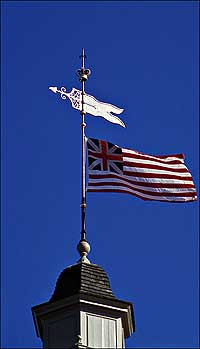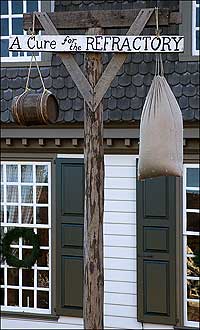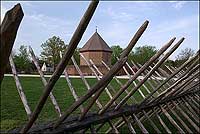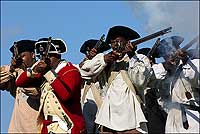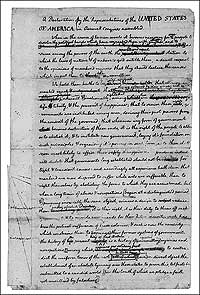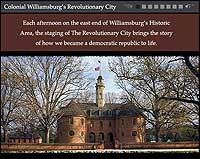A Look at the Revolutionary City
by James Horn
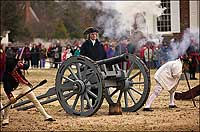
Cannon let fly as Colonial Williamsburg's Thomas Jefferson, Bill Barker, looks across Market Square.
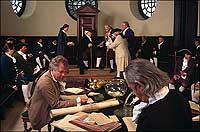
At the Capitol, above, Wayne Moss as Speaker Peyton Randolph and other Colonial Williamsburg interpreters as burgesses are abuzz over the cracking bonds between England and her American colonies.
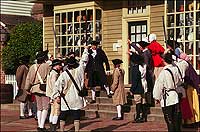
Interpreter Ryan Fletcher, as a Tory merchant loyal to the Crown, faces bumptious townspeople and militiamen pressing their boycott of British goods.
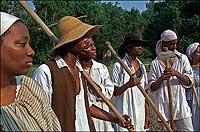
Slaves bristle at cries for freedom while they remain in bondage. From left, Jami Sullivan-Dinisio, Ryan McQueen, Donald Paige, Richard Josey, and Devin Caraday.
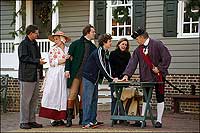
Guest Richard Bowling signs with the Patriots, as parents Doug and Robin Bowling look on alongside interpreters Carolyn Wilson, Scot New, and Ken Treese.
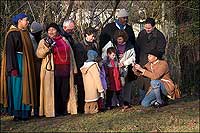
Interpreters and guests Hope Smith, Tiffany Littlejohn, Saundra Williams, Rick Austin, Frances Burroughs, Amani Williams, Isabelle Aczel, Andrew Aczel, Christy Aczel, Art Johnson, Jeff Aczel, and Greg James.
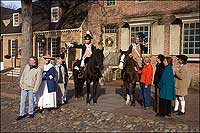
Lafayette, portrayed by Mark Schneider, and his aide, Dennis Watson, chat with Treese, Cindy Gunther, Mark Hutter, Neil Hurst, Susan Pryor, Shien-Mo Hou, Gail Garber, and Menzie Overton.
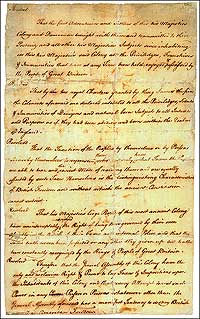
Autograph copy of Patrick Henry's Virginia Resolves which proclaimed the 1764 Stamp Act a usurpation of power by His Majesty's government.
Anyone looking up Williamsburg's Duke of Gloucester Street on May 15, 1776, saw flying from the Capitol's cupola in the afternoon breeze not the Union Jack that had waved over the city since its beginnings but a small banner of red and white stripes. It was the Union Flag of the American states. Virginia had declared itself "for Independency."
The next day, at nearby Waller's Grove, gathered the Committee of Public Safety, delegates of the Fifth Virginia Convention, General Andrew Lewis's troops, and townspeople. Read aloud to them were the convention's resolutions: Virginia's representatives at the Continental Congress at Philadelphia were to propose that the colonies declare themselves free and independent states, "absolved from all allegiance to, or dependence upon, the crown or parliament of Great Britain." They were requested to assent to whatever measures Congress considered necessary for forming a confederation of the colonies and cementing foreign alliances. The convention's members were to draft a declaration of rights and a plan of government for the new state of Virginia.
The throng was regaled by toasts to the "American independent states," the "Grand Congress of the United States," and "General Washington, and victory to American arms," each accompanied by the firing of artillery and muskets, and huzzahs. Fireworks and other "demonstrations of joy" rounded off the day; everyone, according to Alexander Purdie's Virginia Gazette, "seeming pleased that the domination of Great Britain was now at an end."
Before the Revolution, British subjects in America lived in a world in which government was personified in the body of the monarch and ordained by God. America's founding generation threw off the chains of monarchy and turned the world on its head by creating the self-initiating citizen. In the new American republic the people, not the monarch, were sovereign.
The innovation raised questions: What is the role of the citizen? How do citizens shape their government? How do citizens shape their society? How do they shape the future? The questions galvanized the people of Williamsburg during the final quarter of the eighteenth century. They were careful to create a system of self-rule that put the machinery of government into citizens' hands. They expected future generations to recraft that machinery to safeguard individual liberties and to build a better America in ways that the founders knew they could not foresee. They envisioned a system of participatory self-government in which informed citizens and their elected representatives could address and resolve the country's most urgent problems to achieve greater liberty, justice, and opportunity.
The founders were realistic. They understood that the experiment would be difficult to maintain and required continuing debate. They knew that a healthy democracy is often contentious, even rancorous, but they believed that educated citizens engaged in dialogue with one another best protected the individual's rights.
Nowadays, many young Americans no longer learn or appreciate that representative democracy requires individual commitment and engagement at all levels. Many Americans are less certain about their civic responsibilities than they once were.
Colonial Williamsburg has begun an initiative, Education for Citizenship, that has relevance for times such as these. Its aim is to help people make the connection between what took place in the American Revolution and the founding of the nation, and what is taking place today.
It comes in the form of an invitation to visitors and distance learners to enter the country's never-ending conversation about the rights and responsibilities of citizenship. It encourages every twenty-first-century American to take the revolutionary journey traveled more than 200 years ago by the residents of the town that is now an outdoor classroom and a broadcast studio. The history lessons of Education for Citizenship are intended to remind everyone that democratic dialogue is essential to sustaining and advancing the liberties invested in each of us.
Starting in spring 2006, Colonial Williamsburg's living history experience will be revised. The Historic Area will be involved in the on-site presentation of a new program, "From Subjects to Citizens: Our Struggle to Be Both Free and Equal," which includes a dynamic, interactive environment: the Revolutionary City.
At the east end of the Historic Area, between Botetourt and Waller Streets, scenes played out on the Duke of Gloucester Street, in the buildings, and on their grounds are to portray Williamsburg's role in the American Revolution and birth of the republic, the first modern democracy.
The Revolutionary City is to be staged each afternoon, from 2:30 to 4:30 p.m., on two consecutive days. Day one, the "Collapse of Royal Government," covers May 1774 to May 1776, and depicts events that persuaded Virginians and other Americans to declare themselves a free and independent people. Day two, "Citizens at War," which covers June 1776 to September 1781, highlights the tests and trials that befell Williamsburg's inhabitants as they shaped a new society in the midst of war.
Each follows the same format: A large-scale opening event introduces visitors to the themes of the story and is followed by scenes that provide the perspectives of townspeople. Another large-scale event at the midpoint of the afternoon presents a development in the story and is followed by scenes that elaborate on the central theme. A large-scale closing event culminates the performance and provides opportunities to sum up the significance of the years portrayed as well as speculate about the future.
On day one, the opening event depicts the beginning of the crisis in Virginia. At the end of May 1774, a group of townspeople, hearing that Governor Dunmore is on his way to the Capitol, discuss news of the closure of the port of Boston and what it might mean for them. The governor's carriage draws up, and his lordship enters the Capitol to appear on the balcony a few minutes later. Visibly angry, he explains to the crowd why he has been forced to dissolve the General Assembly and bids them disperse and go about their business. Staying put after the governor leaves, however, townspeople hear from unrepentant burgesses about their plan to meet at the Raleigh Tavern the following day to ban the importation of British goods and to propose an annual congress of representatives of the colonies to protect American interests. From the crowd come shouts of approval and a few cries urging caution.
Scenes that follow depict an argument between leading gentry and men who decide to take the law into their own hands by erecting a liberty pole to enforce compliance with the association. Meanwhile, a group of slaves, including Eve of Speaker Peyton Randolph's household, discuss the irony of their masters' protest about being enslaved by the British while they experience the harsh realities of bondage. Subsequent scenes continue the story through the spring and summer of 1775, when relations between the colony's leaders and Dunmore deteriorate into preparations for war.
In the autumn, the governor proclaims emancipation for slaves who would take up arms against their rebel masters. It kills any chance of reconciliation and poses enslaved Virginians a dilemma. Should they leave their homes and families and endanger their lives for the chance for freedom? What would happen if the governor reneged or if they were captured and returned to their masters? As the war in Hampton Roads intensifies across the winter, many Virginians turn toward independence. Day one ends with the celebration of the convention's resolutions of May 15.
Day two, "Citizens at War," emphasizes the experiences of Williamsburg's townspeople as, against the backdrop of the gathering conflict, they created a self-governing society. Having declared independence, they had to achieve it.
Besides such figures as Thomas Jefferson, Benedict Arnold, and George Washington, guests in the Revolutionary City encounter such characters as Barbara Hoy, wife of a poor man captured at Charleston, a group of merchants and townspeople protesting against the high price of food in the summer of 1779, and a free black Baptist preacher, Gowan Pamphlet, who talks about his hopes for a future in which all citizens are equal and there is no official state religion.
Beginning with the public reading of the Declaration of Independence on July 25, 1776, and ending with Washington's address to his troops before the march to Yorktown, these stories underline the reality of war and occupation, the uncertainty of the times, the choices and sacrifices people were forced to make, their daily struggles, hopes, and fears, and their growing sense of nationhood.
In addition to major scenes and events, scripted by a professional writer and performed by a troupe of actor-interpreters, Colonial Williamsburg has designed a repertoire of smaller scenes on the Revolutionary City streets, in such trade shops as the apothecary, silversmith, wigmaker, and millinery, and in such public buildings as the Capitol, Gaol, and Raleigh Tavern. They provide the backdrop, or backstory, and allow development of the characters guests may have already encountered in the major scenes.
Having heard Arnold announce terms of the British occupation of Williamsburg in the spring of 1781, for example, they might meet him taking his ease with fellow officers behind the Raleigh Tavern, where they can quiz him on why he abandoned the American cause and joined the British. These small scenes help to bring the Revolutionary City alive—the talk on the streets, stump speeches, rumors, impromptu protests, runaways, the coming and going of townspeople and soldiers—creating the everyday drama of the community and investing the streets with activity and life.
Throughout the Historic Area, guests will find a broader context for the Revolutionary City. At the Courthouse, the Committee of Safety meets to commission officers, organize the raising of Virginia regiments, and act against locals hostile to the new government. Enslaved men and women at the Peyton Randolph House and Great Hopes Plantation talk of the meaning of independence for them and hopes of liberty. At the Governor's Palace, guests might hear Dunmore's side of the story as he prepares to flee Williamsburg. At his Wythe House headquarters, Washington prepares for battle at Yorktown. Williamsburg helped midwife the birth of the idea of our republic. In Williamsburg, individuals cast off the mantle of subjects and became citizens. Increasingly, these first citizens came to realize that the future of their democracy depended on their participation, on taking part, and on helping to shape the events that would change their lives and the lives of generations to come.
Within the Revolutionary City and outside it, guests will be encouraged to take a stand, posit an opinion, vote, and argue. It was the engagement of grassroots citizens' argument and debate that formed a community and forged a nation. Guests will discover in the scenes in which they play a role the continuing story of the republic.
Technology will play a comprehensive role in the programming—interactive media, DVDs, and online resources—and at the Kimball Theatre and the DeWitt Wallace Museum, films, events, and exhibitions support and amplify citizenship themes.
Outreach programs will offer complementary materials contextualizing the Revolutionary City experience, allowing guests to explore the emergence of a stronger national government after the war, the creation of the federal Constitution, the role of the courts, the balance of state and federal rights, and the struggle for equal rights and freedom by those excluded from citizenship in 1776.
Education for Citizenship has encouraged expansion of the current K–8 school offerings to the high school level, distributed through a variety of media but primarily by the Web. This will be a subscription-based service for registered schools, school systems, and home schoolers.
A new Web site is to provide broader perspectives on citizenship than is possible in the Revolutionary City. Its core will be an exploration of the roles, rights, and responsibilities of citizens in democratic republican societies, and will be built around the May 15 resolutions, the Virginia Declaration of Rights, the Virginia Constitution, the Declaration of Independence, and the Virginia Statute for Religious Freedom. It is intended for a worldwide audience and to speak to individuals no matter their origin, ethnicity, or nationality, providing a multilingual and multicultural interpretation of the ideas at the heart of the American experiment.Resources included in this public site will be shared with the secondary education and teacher subscription services.
The ideas that underpinned the Revolution and the creation of a new Virginia society influenced the history of the nation. In Williamsburg, Patrick Henry struck an early blow for liberty with his speech against the Stamp Act; in the Capitol, in the taverns and shops, in the newspapers, and on the streets, townspeople debated the limits of government and rights of citizens. Thomas Jefferson, George Mason, Arthur Lee, Richard Henry Lee, and James Madison refined the principles that would justify American resistance to Great Britain, and honed the precepts that would guide the Republic. Education for Citizenship and the Revolutionary City address the relevance of those principles, principles that remain as important for our own times as they were for theirs.
James Horn is director of research and the Abby and George O'Neill Director of the John D. Rockefeller, Jr. Library at Colonial Williamsburg. This is his first contribution to the journal.
For More Information
The Revolutionary City

